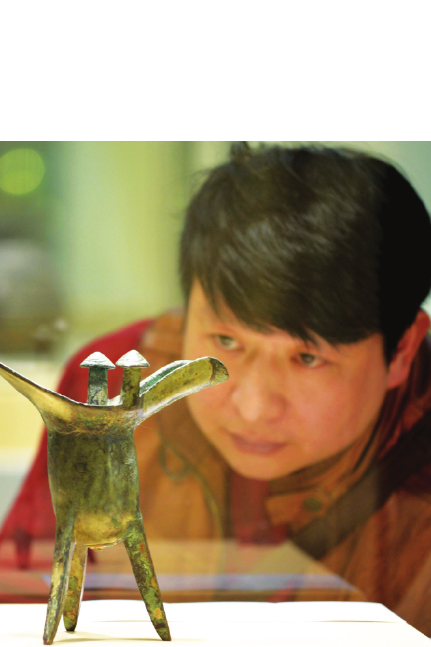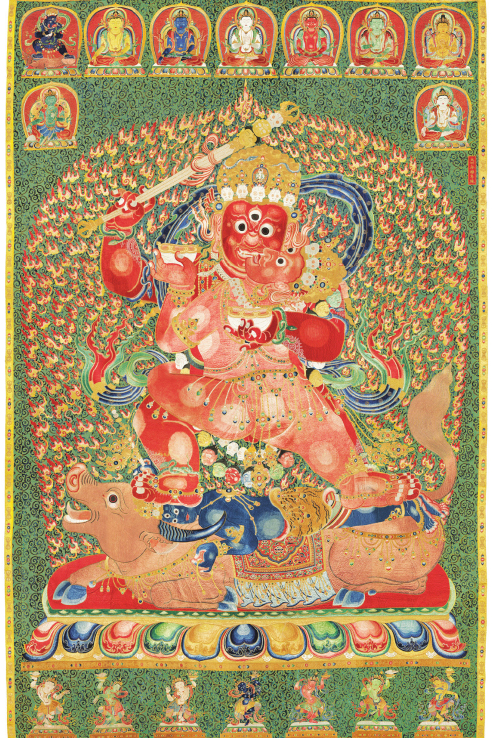
Antique bronzeware sold by the Xiling Yinshe Auction Company in Hangzhou, Zhejiang province.[Photo/China Daily]
Although deals in the Chinese mainland art market shrank a little in 2014 compared to the previous year, the continuing strong demand for antique paintings and scrolls, along with Chinese collectors’ rise on the international stage and diversified auctions, are all sustaining hope in the growth of the art market.
Sales in auction houses in China from January to September totaled 15.3 billion yuan ($2.5 billion), says Ouyang Shuying, deputy secretary-general of the China Association of Auctioneers. With autumn auctions ending, major houses like China Guardian and Poly Auction that represent more than half the art market have seen an average 20 percent drop in sales.
However, experts who attended the recent Chinese Art Market Summit say that China’s art market is “never in need of money” but is currently in need of confidence and masterpieces.
White Pagoda Hill, a set of hand scrolls by Emperor Qianlong of the Qing Dynasty (1644-1911), fetched 116 million yuan at a Poly Auction event on Dec 2, setting a record for Chinese paintings and calligraphy.
“It has been really hard for us to persuade collectors to sell this year,” says Dong Guoqiang, president of the Beijing Council International Auction Company. “China’s art market is still in a transitional year. But we are not short of money. Just look at China’s stock market. It (value of transactions) achieved 1.2 trillion yuan in a single day.”
Dong says that there are few high-quality artworks to attract good prices-meaning prices of more than 100 million yuan-offered by Chinese collectors in 2014. But that has not prevented them from turning to the international market to invest in Western art.
After Dalian Wanda Group’s real estate mogul Wang Jianlin bought Pablo Picasso’s Claude et Paloma at Christie’s for $28.2 million, movie tycoon Wang Zhongjun purchased Vincent van Gogh’s 1890 painting Still Life, Vase with Daisies and Poppies for $61.76 million at a Sotheby’s auction in New York in November.
Talking about his expensive purchase, Wang Zhongjun says the price was $10 million lower than what he had expected.
“I loved it at first sight when it was on preview in Hong Kong. I didn’t think much before my purchase. I just love it,” says Wang.
He already owns paintings by Claude Monet, Paul Cezanne and Pierre-Auguste Renoir.
“I enjoy sitting on a couch with a cigar and looking at these masterpieces hanging on the walls in my house,” says Wang, whose collection also includes Chinese paintings and sculptures.

Collector Liu Yiqian offered HK$348 million ($45 million) for this embroidered silk thangka in a November auction.[Photo/China Daily]
However, some collectors are spending big on domestic art. Liu Yiqian made several big overseas purchases of Chinese antiques.
Early last year, Liu bought a chicken cup that was used by emperors of the Ming Dynasty (1368-1644) at a Sotheby’s auction for a record price of $36.3 million. In November, he offered HK$348 million ($45 million) at a Christie’s auction for an embroidered silk thangka, a type of painting on fabric usually depicting Buddhist imagery.
After the purchase, Liu joked on his micro blog, saying: “I exhausted myself to successfully win the thangka from a foreign bidder. I was so willful.” The post won him a nickname from netizens: “Willful man”. But Liu explained later, at the Chinese Art Market Summit, that he bought the thangka due to his deep fondness for it.
Both purchases at such high prices have stirred some criticism from the public on the value and prices of artworks.
“It’s childish to focus only on the price of an artwork. We should spend more time understanding their priceless value,” says Liu, who established the Long Museum, a private museum in Shanghai.
Dong from the Beijing Council says the cultural environment should be more tolerant and that people should not criticize a collector because of expensive purchases of masterpieces.
“We should encourage more of our collectors to buy things overseas. They have set up their own collection systems instead of buying randomly. They have started to take on an international vision,” Dong says.
To woo back Chinese collectors who have been buying overseas, domestic auction houses have actively diversified their artworks.
This year, the number of special auctions devoted to a particular category has increased sharply, such as hardwood furniture from the Ming Dynasty and antique clothes from the Ming and Qing dynasties.
The recent auction of China’s antique bronze ware by Xiling Yinshe Auction Company in Hangzhou, capital of East China’s Zhejiang province-among the first of its kind in China-was a success, with all of the pieces selling fast.
Zhao Xu, president of China Guardian, says that Jack Ma, founder of e-commerce giant Alibaba Group Holding Ltd, has promised to invest more in the company’s cooperation with the auction house.
